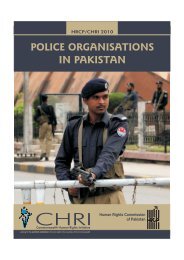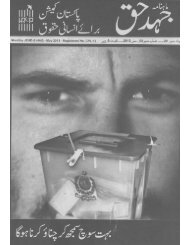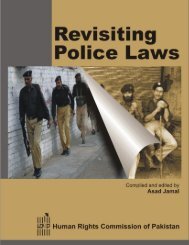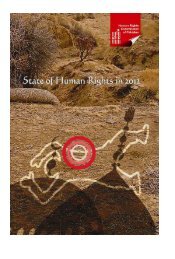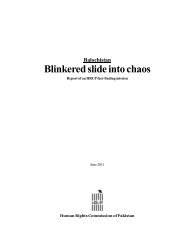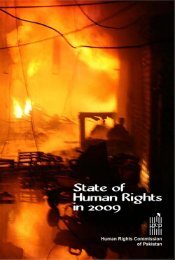Download PDF file - Human Rights Commission of Pakistan
Download PDF file - Human Rights Commission of Pakistan
Download PDF file - Human Rights Commission of Pakistan
You also want an ePaper? Increase the reach of your titles
YUMPU automatically turns print PDFs into web optimized ePapers that Google loves.
the main security threat, the lessons <strong>of</strong> Muharram policing appear not have been much in<br />
evidence in the preparation for May 12. In fact, some <strong>of</strong> the known preparations for May 12th<br />
were in direct contradiction to the lessons <strong>of</strong> successful policing <strong>of</strong> Moharram processions.<br />
While there is some logic in setting up roadblocks and barricades to channel rival processions<br />
away from one another and to restrict the number <strong>of</strong> entry points into the main procession<br />
route, the setting up <strong>of</strong> barriers across the main route <strong>of</strong> the rallies – i.e., on Sharah-e-Faisal –<br />
appeared to make no sense at all. Rather than facilitating the passage <strong>of</strong> the two rival rallies,<br />
the barriers actually ensured that none <strong>of</strong> the rallies could actually pass.<br />
There is no evidence either <strong>of</strong> a serious attempt at negotiating a time-lag between the<br />
two potential rival rallies. There was an indication that among the options being considered by<br />
the government one included allowing the CJ to move from the airport after the MQM rally<br />
had ended. It is not known if this option was pursued with any seriousness. There is also no<br />
evidence that the authorities made any attempt to persuade the MQM to alter the route or<br />
timing <strong>of</strong> its proposed rallies along the National Highway/Sharah-e-Faisal corridor. As it<br />
turned out, there was no MQM rally along the National Highway/Sharah-e-Faisal corridor<br />
towards the Quaid’s Mazar and M.A. Jinnah Road. It is, therefore, quite likely that the<br />
authorities had already decided that there would not be any rival rallies along the route. The<br />
objective, it then appears, was to obstruct opposition rallies.<br />
The roadblocks were also the wrong instruments for dealing with the other three<br />
security threats, as perceived by authorities. Again, as the experience <strong>of</strong> VVIP movement<br />
along the Shara-e-Faisal corridor shows, avoiding any <strong>of</strong> the three kinds <strong>of</strong> threats requires<br />
blocking <strong>of</strong> entry onto Sharah-e-Faisal from the side roads and unimpeded flow <strong>of</strong> traffic along<br />
the corridor. While the former procedure was carried out, i.e., entry onto Sharah-e-Faisal<br />
from the side roads was restricted, the placing <strong>of</strong> barriers across Shahrah-e-Faisal created ideal<br />
conditions for an assassin, a suicide bomber or a terrorist aiming to target or ambush anyone.<br />
HRCP<br />
2. Flashpoints on May 12 and After<br />
At least 34 people were killed and 140 injured on May 12 th alone as parts <strong>of</strong> Karachi<br />
turned into battlegrounds 41 . The main areas that saw fierce clashes between rival groups were<br />
along the National Highway/Shahrah-e-Faisal corridor, as well as in other parts <strong>of</strong> the city.<br />
The situation was so grim that the Jinnah Postgraduate Medical Centre (JPMC) receptionist<br />
asked those enquiring for their loved ones to first check the morgue 42 .<br />
An overall picture <strong>of</strong> the May 12 events is reconstructed in this section using published<br />
accounts and individual testimonials <strong>of</strong> victims and eyewitnesses. An attempt is made to<br />
identify flashpoints, or locations where violence and casualties are known to have taken place,<br />
and to provide an account <strong>of</strong> what happened at these various locations during the course <strong>of</strong><br />
the day.<br />
The earliest reports <strong>of</strong> violence relate to the difficulties experienced by lawyers in<br />
reaching their designated meeting points in the City Courts, the Sindh High Court and the<br />
Malir District Courts respectively. This violence was threatening but mostly non-lethal.<br />
However, from around midday onwards, many segments <strong>of</strong> the National Highway/Sharah-e-<br />
Faisal corridor experienced intensive use <strong>of</strong> firearms and a large number <strong>of</strong> casualties and<br />
injuries caused by firing. Violence then spread to other parts <strong>of</strong> the city from around 1.30 pm<br />
41<br />
Dawn 13 May (i)<br />
42 Daily Times 14 May (b)<br />
10



